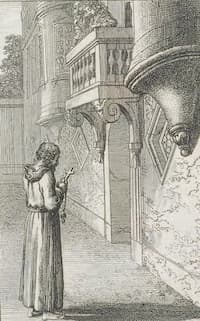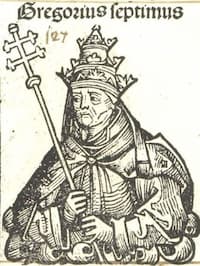Gregory VII was Pope (1025-1085). He is known for the Gregorian Reform, which brought renewal and change to the Catholic Church, and for the Investiture Controversy with Emperor Heinrich IV that resulted from it. This article explains why the Gregorian Reform and the Investiture Controversy are so important in European history at large, not just in Church history.
Life of Gregory VII
Gregory VII was born into a middle-class family in Tuscany, northern Italy. His real name was Hildebrand. He studied in Laterano and Cologne. Later he moved to Rome.
In Rome in 1049, Hildebrand became abbot of the Benedictine monastery of Saint Paul by the encouragement of then Pope Leo IX. He also served as papal ambassador in Germany, France, and Italy. In 1073, he acceded to the papal throne as Pope Gregory VII.
The Impact of Gregory’s Reform
Shortly before the accession of Gregory VII, papal-led reforms had been gaining momentum in the Catholic Church and were gradually being put into practice. Gregory had been assisting it even before his accession. When he finally ascended the throne, the reform was in full swing. Hence, it is called the Gregorian Reform.
The Gregorian Reform was a very ambitious attempt to change the existing relationship between the pope and the emperor or king and to create a system of papal supremacy. This attempt led to the Investiture Controversy. Therefore, in order to understand well the Investiture Controversy, it is first necessary to understand well the Gregorian Reform.
First of all, it is important to point out the aspect of church renewal. Specifically, it prohibited the selling of clerical positions, the marriage of clergy, and so on.
The Bull “Dictatus Papae”
Furthermore, in 1075, Gregory promulgated the famous Bull “Dictatus Papae”. As pope, he issued a decree. In this bull, the vision of Gregory’s reform is expressed. Four points are important.
The first is clericalism. This was to make a sharp distinction between the sacred and the secular and to show the superiority of the clergy. Until then, the distinction between laity and clergy existed. However, for Christians, the distinction between the two was often unimportant. However, the Gregorian Reform made a clear distinction between the two. It was then argued that the clergy were superior to the laity as human beings.
Why? In the medieval Christian view, the secular belongs to this world. This world is only temporary, which will eventually disappear at the Last Judgment. The spiritual, on the other hand, belongs to God and Christ and will continue to exist forever even after the Last Judgment. For this reason, the spiritual and the secular are distinguished as two very different things. Furthermore, spiritual things are by far superior and more valuable than worldly things. The secular corresponds to the laity whereas the spiritual corresponds to the clergy, as servants of God. Therefore, the clergy is a higher human being than the laity.
Second is the freedom of the Church. Until then, the Christian church was often led by secular princes such as emperors and kings. For example, the Roman Emperor Constantine I and the Holy Roman Emperor Karl the Great. The same is true of the Byzantine Emperors. The emperors appointed high-ranking clergy, determined doctrines, and convened major church councils.
Gregory attempted to change this tradition. Under clericalism, the church must be led by a clergyman, not a secular person like an emperor or king. Therefore, Gregory attempted to remove emperors and kings from the leading positions in the church.
Third, the church is a monarchy. In other words, the Christian church has a pyramidal organizational form. It is a system of centralization. At the top of the pyramid reigns not a king nor an emperor, but a clergyman. It is none other than the Pope. Therefore, the Pope is the leader of the Church. In the hierarchy of the Church, priests are considered to be higher than kings and emperors. This is not the case in the secular hierarchy.
Fourth, the pope is superior to emperors and kings even in secular matters. Therefore, the pope can not only excommunicate emperors and kings as an ecclesiastical punishment, but also depose them. In other words, the Pope can take away imperial or royal power. Naturally, such a claim would be vehemently opposed by emperors and kings. The pope was also criticized for his secular ambitions.
At the same time, the Gregorian Reform was set against a background of conflict with the Greek Orthodox Church in the East. The Roman Pope was the self-appointed head of the Catholic Church in Western Europe. The Orthodox Church existed in the Byzantine Empire to the east. In 1054, the Catholic Church and the Orthodox Church came into harsh conflict over doctrines and supremacy. In this vein, the Gregorian Reform declared the Roman Pope to be the head of Christianity, not only in Western Europe but in the world as a whole. Thus, the Gregorian Reform was also a struggle for the leadership of the entire Christian Church.
Gregory promoted such a ambitious reform. Naturally, he faced various opposition. This movement continued into the modern era.
The Investiture Controversy
In this vein, Gregory also prohibited laity from ordaining clergy. Furthermore, Gregory had a conflict with Holy Roman Emperor Heinrich IV over the appointment of the archbishop of Milan. These events led to the Investiture Controversy.
The Investiture Controversy arose over whether an emperor or king had the right to appoint or ordain a clergyman. The lack of these rights by emperors and kings was a considerable blow to themselves in the society of the time. This was because high-ranking clergy, especially bishops, often also served as lords of the same region. For exemple, the archbishop of New York, so to speak, was also the governor of New York. Therefore, if the emperor could not choose the archbishop of New York, he could not choose the governor of New York either. Rather, a governor who sided with the pope would be chosen. Hence, the Investiture Controversy intensified.
The Road to Canossa
The above-mentioned conflict over the appointment of the Archbishop of Milan intensified. In 1076, Heinrich declared that he would dismiss Gregory VII. In response, Gregory declared that he would excommunicate the emperor. In 1077, the emperor relented. He asked for a reversal of his excommunication at the castle of Canossa in northern Italy.
Incidentally, it was the abbot of the Cluny monastery at that time who became the guarantor of the emperor’s apology in this situation. The abbots of the Cluny monastery at that time were the heads of large organizations, numbering over 1,000.

Heinrich IV begging the forgiveness of Gregory VII
Gregory’s indignation and death.
But the emperor regained power and went on a reversal offensive. Gregory again declared excommunication against him, but to no avail; in 1084 , the emperor finally attacked and occupied Rome.
Gregory fled to Salerno. The emperor replaced Gregorius with a new Pope, Clement III. It is said that Gregory died there in indignation, unable to recover.
The Importance of Gregory VII
The reforms of Gregory VII are said to have defined the course of the subsequent papacy. Along with him, Innocent III and Boniface VIII were known as representative of papal supremacy that aimed to expand the interests of the papacy.
Gregory VII was canonized by Pope Paulus V in 1606.
People associated with Gregory VII.
Emperor Heinrich IV: He was the opponent of Gregory VII. How does the Investiture Controversy look like from the emperor’s point of view?

Recommended or Selected References
瀬戸一夫『時間の政治史 : グレゴリウス改革の神学・政治論争』岩波書店, 2001
井上雅夫『西洋中世盛期の皇帝権と法王権 : ハインリヒ三世・グレゴリウス七世・ハインリヒ四世をめぐって 』関西学院大学出版会, 2012
Francis Oakley, The mortgage of the past : reshaping the ancient political inheritance (1050-1300), Yale University Press, 2012

